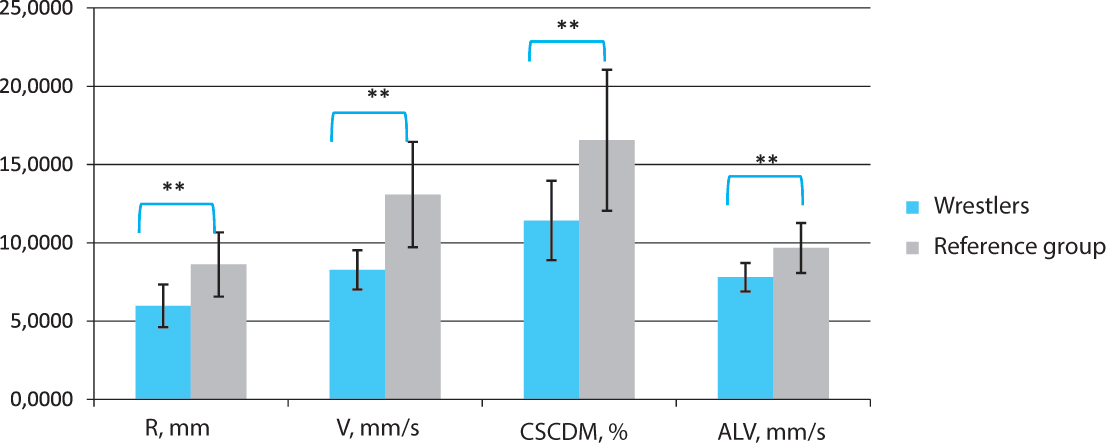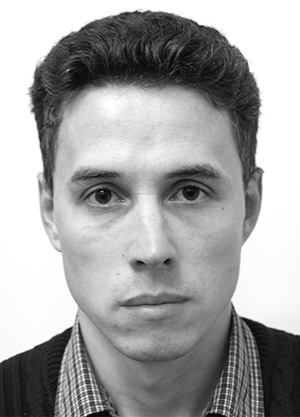Changes in hemodynamic and stabilographic characteristics at orthostatic tests of athletes practicing wrestling
Фотографии:
ˑ:
Ph.D. F.A. Mavliev
Ph.D. A.S. Nazarenko
Professor, Dr.Hab. F.R. Zotova
Associate Professor, Dr.Biol. A.A. Nabatov
Volga Region State Academy of Physical Culture, Sport and Tourism, Kazan
Keywords: hemodynamic and stabilographic characteristics, orthostatic test, body balance, athletes
Introduction. When the body position changes, the body fluids are actively redistributed, which necessitates rapid adjustment of the cardiovascular system (CVS) to the changed conditions of its operation [1-4]. In addition, extreme reactions of the CVS can be expressed in postural tachycardia and hypotension. Among the functional loads that cause specific decentralization of the blood flow are also rotations of the body, such as, for instance, during vestibular stimulation in a Barany chair [5].
The examination of athletes also included the active orthostatic test of the reaction of the autonomic nervous system as related to the changes in the indices of the CVS [1, 2]. Orthostasis leads to an accentuated reduction in venous return, which starts urgent adaptation processes by means of activation of the vasomotor center [6, 7]. Measurement of these changes allows to determine the specific features of the autonomic support of the CVS that depend on a variety of factors, including initial vegetative tonus [1] and fatigue level [8-10]. It has been demonstrated that athletes have their individual reactions to orthostasis [11, 12], which largely depend on their sports specialization [13, 14].
Objective of the study was to analyze the peculiarities of response of the body balance and blood circulatory system of athletes with respect to the norm and after an active orthostatic test.
Methods and organisation of research. In this paper we analyzed changes in the circulatory indices, obtained by means of rheography of the balance function using the stabilometric platform. The adolescent subjects were split into 2 groups: those not involved in sports (11 people) and athletes practicing wrestling (13 people). The body-weight parameters of the subjects did not differ statistically significantly. The average height in the group of wrestlers was 174.76±5.5 cm versus 178.9±5.9 cm in the reference group (p=0.832); the average weight was 73.38±7.60 and 74.10±8.37 kg respectively (p=0.091).
All subjects were at least I Class athletes. The study consisted of 2 stages: the 1st stage - recording of the balance function indices using the Romberg test with the eyes open (52 seconds per trial before the orthostatic test), and recording of the blood flow indices in the supine position for 4 minutes; 2nd stage - recording of the circulatory function and body balance indices immediately after standing upright (on the stabilometric platform) for 52 seconds.
The circulatory indices were registered using the MARG 10-01 rheograph ("Microlux" LTD, Chelyabinsk). The procedure of registration of the circulatory parameters was based on the impedance measurements in the survey area (the chest area). We registered: stroke volume (SV) - according to electrocardiogram (ECG) and the first derivative of transthoracic rheogram (ml); minute blood volume (MBV l/min); blood pressure (BP, mm Hg) - by pulse wave velocity (between "R" wave of the ECG and peak of the first derivative of the pulse wave of the finger microcirculatory vessels); heart rate (HR) - according to electrocardiogram (bpm).
The body balance regulation was estimated using the Stabilan 01-2 hardware-software complex (CJSC "OKB" "Rhythm", Russia) by analyzing the center-of-pressure oscillations. During the test, the subject was standing on a stabilometric platform in the normal stand position (52 s), barefoot, with his eyes open, arms stretched out along the trunk. The feet were in the standard position: heels in, toes out (30° angle). The body balance function before and after the orthostatic test was analyzed using the following stabilographic characteristics of the center-of-pressure (CP) oscillations: QX, mm - variation in the frontal plane; QY, mm - variation in the sagittal plane; R, mm - average range; VAVG, mm/s - average linear velocity of the center-of-pressure movement; VS, mm2/s - rate of change of the area of statokinesiogram; SELLS, mm2 - confidence ellipse area of statokinesiogram; IV, c.u. - velocity index; ME, c.u. - motion estimation; QEF, % - quality of the equilibrium function; CSCDM, % - coefficient of sudden change in direction of movement; NAV, mm2/s - normalized area of the vectogram; ALV, mm/s - average linear velocity registered during the study.
The data were statistically processed using the SPSS 20 software. The samplings were checked for the value distribution pattern using the Kolmogorov–Smirnov test, the statistical significance of differences between the samplings - using the Student's t-test. The data in the text, tables and figures are presented as an arithmetic mean and standard deviation (M ± s). The differences were considered statistically significant at p<0.05.
Results and discussion.
Indices before the orthostatic test. The study has not revealed any significant differences in the impedancometric markers of blood circulation between the group of wrestlers and those not involved in sports (Table 1), except for diastolic blood pressure.
Table 1. Circulatory and balance function indices in wrestlers and in reference group (M ± s)
|
Indicators |
Stages |
Wrestlers |
Р1 |
Reference |
Р2 |
Р3 |
|
SBP, mm Hg |
Before |
121.67±17.45 |
.230 |
130.64±17.32 |
|
|
|
after |
135.25±16.64 |
.352 |
142.18±18.14 |
.000 |
.001 |
|
|
DBP, mm Hg |
before |
65.00±7.80 |
.009 |
74.73±8.20 |
|
|
|
after |
78.25±10.15 |
.138 |
84.27±8.53 |
.000 |
.000 |
|
|
BPAVG |
before |
86.67±12.14 |
.066 |
95.77±10.35 |
|
|
|
after |
84.49±9.56 |
.027 |
95.50±11.70 |
.328 |
.875 |
|
|
HR, bpm |
before |
68.20±10.87 |
.982 |
68.30±10.64 |
|
|
|
after |
90.82±16.00 |
.825 |
89.62±9.99 |
.000 |
.000 |
|
|
SV, ml |
before |
130.94±28.02 |
.503 |
137.67±20.23 |
|
|
|
after |
109.41±27.12 |
.422 |
117.67±22.35 |
.000 |
.000 |
|
|
QX, mm |
before |
2.69±0.60 |
.912 |
2.67±0.59 |
|
|
|
after |
3.09±0.65 |
.139 |
3.61±0.94 |
.052 |
.005 |
|
|
QY, mm |
before |
3.60±0.76 |
.218 |
4.04±0.91 |
|
|
|
after |
4.28±0.82 |
.005 |
5.36±0.85 |
.031 |
.000 |
|
|
VS, mm2/s |
before |
4.97±1.74 |
.394 |
4.46±0.89 |
|
|
|
after |
9.26±5.63 |
.248 |
7.18±1.55 |
.003 |
.000 |
|
|
SELLS, mm2 |
before |
82.92±16.75 |
.000 |
137.06±31.74 |
|
|
|
after |
151.93±17.41 |
.000 |
224.29±42.51 |
.000 |
.000 |
|
|
IV, c.u. |
before |
4.93±0.62 |
.065 |
5.72±1.17 |
|
|
|
after |
5.65±1.30 |
.003 |
7.45±1.30 |
.046 |
.000 |
|
|
ME, c.u. |
before |
37.83±10.29 |
.361 |
42.06±11.91 |
|
|
|
after |
32.32±9.45 |
.033 |
40.85±8.80 |
.095 |
.622 |
|
|
QEF, % |
before |
90.34±1.69 |
.000 |
80.17±4.34 |
|
|
|
after |
84.29±2.99 |
.000 |
69.15±5.37 |
.000 |
.000 |
|
|
NAV, mm2/s |
before |
0.16±0.06 |
.004 |
0.26±0.09 |
|
|
|
after |
0.20±0.09 |
.004 |
0.33±0.11 |
.116 |
.008 |
Note. Р1 – significance of inter-group differences, Р2 and Р3 – significance of differences between the stages in the group of wrestlers (Р2) and non-athletes (Р3).
A different situation is observed in the data obtained using the stabilometric platform. Thus, wrestlers (Fig. 1) had a shorter radius of the ellipse (30.66%; p=0.002), lower velocity of center-of-pressure movement (by 36.72%, p=0.0007), lower coefficient of sudden change in the direction of center-of-pressure movement (by 30.96%, p=0.014) and ALV (by 19.27%, p=0.004).

Fig. 1. Stabilographic characteristics of body balance in wrestlers and non-athletes before active orthostatic test
Note: ** - statistical significance of differences at p<0.005
Changes in the indices after the orthostatic test. The differences in the cardiovascular indices after the orthostatic test were registered in the examined groups only in respect to the values of average blood pressure, which was 11% lower (p=0.027) in the group of wrestlers. Non-athletes were observed to have lower dynamics in the range of center-of-pressure deviations (increased by 21.21% versus 25.74%, p=0.0003), the linear speed of center of pressure (increased by 28.72% versus 31.78%, p=0.0006) and the confidence ellipse area (increased by 63.63% versus 83.21%, p=0.00001). The dynamics of displacements in the frontal plane were less pronounced in the group of wrestlers (18.89% versus 32.48% in the reference group, p=0.005), which testifies to the high static stability of the vertical body position in this plane.
Conclusion. The fact that wrestlers and individuals not involved in sports have statistically significant differences in the QEF and cardiovascular indices, both at rest and in response to the orthostatic test, allows for the conclusion that the quality of the balance function and its display when changing the body position are influenced by specifics of sports activity .
References
- Voronov, N.A. Ortostaticheskoe testirovanie v otsenke funktsional’noy gotovnosti yunykh voleybolistok (Orthostatic test in functional fitness measurement in youth women's volleyball) / N.A. Voronov // Vestnik TGPU. – 2009. – № 8. Available at: http://cyberleninka.ru/article/n/ortostaticheskoetestirovanievotse... (access date: 17.10.2014).
- Kudrya, O.N. Osobennosti srochnoy adaptatsii serdechnososudistoy sistemy sportsmenov s razlichnym iskhodnym vegetativnym tonusom pri ortostaticheskom testirovanii (Urgent adaptation of cardiovascular system of athletes with different initial autonomic tonus during orthostatic test) / O.N. Kudrya // Vestnik TGPU (Herald of TSPU). – 2011. – № 5. Available at: http://cyberleninka.ru/article/n/osobennostisrochnoyadaptatsiiserd... (access date: 15.10.2014).
- Mel’nikov, A.A. Kardiogemodinamicheskaya ustoychivost’ k ortostaticheskomu vozdeystviyu u sportsmenov posle aerobnoy fizicheskoy nagruzki (Cardiohemodynamic orthostatic tolerance in athletes after aerobic exercise) / A.A. Mel’nikov, S.G. Popov, A.D. Vikulov // Fiziologiya cheloveka. – 2014. – V. 40. –№ 3. – P. 86–95. – Ref.: P. 9495. – ISSN 01311646
- Mel’nikov, A.A. Popov, S.G., Nikolaev, D.V. Bioimpedansnyiy analiz deponirovaniya krovi v perefiricheskikh regionakh vo vremya tilltesta u sportsmenov (Bioimpedance analysis of peripheral blood storage during Till test of athletes) / A.A. Mel’nikov, S.G. Popov, D.V. Nikolaev // Regionarnoe krovoobrashchenie i mikrotsirkulyatsiya, – 2013. – № 4. – P. 61–69.
- Yakhontov, S.V. Mekhanizmy i faktory vzaimodeystviya zvenev serdechnososudistoy sistemy pri perekhodnykh protsessakh (analiticheskiy obzor, chast’ 1) (Mechanisms and factors of cardiovascular component interaction during transient processes (analytical review, part 1) / S.V. Yakhontov, A.V. Kulemzin, O.N. Chufistova // Vestnik TGPU (Herald of TSPU). – 2010. – № 3. Available at: (access date: 17.10.2014).
Corresponding author: zfr-nauka@mail.ru\


